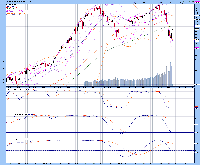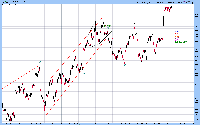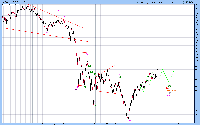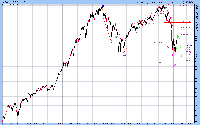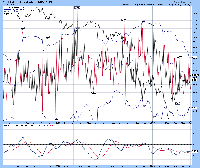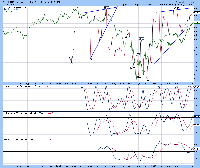|
|||
Update of the S&P 500 IndexDavid Petch The daily chart of the S&P 500 Index is shown below, with upper 21 and 34 MA Bollinger bands riding the index higher while lower BB’s continue to rise alongside the index, along with a potential Elliott Wave count displayed (which has a lower probability of occurrence compared to the other displayed patterns. Full stochastics 1, 2 and 3 are shown below in order of descent, with the %K above the %D in stochastics 1 and 3. If the %K can manage to remain hooked up and cross the %D in stochastic 2, it increases the likelihood that the continued price movement in the S&P 500 index drifts between 900-1000 over the course of the next 1-2 weeks at a minimum before topping out. As the Captain noted and as Elliott Wave charts will later show, there is a chance the markets simply go sideways for the summer before having a fall crash…to risky for most to even attempt playing, so use risk capital and no more than 5% on any given market trade. (Click on images to enlarge) Figure 1 The weekly chart of the S&P 500 Index is shown below, with upper 21 and 34 week MA Bollinger bands in close proximity to the index, while the lower 34 MA BB has shot above the 21 MA BB, indicating the mid-term trend is overbought. It is important to note that the 55 MA BB is at 484.99, well below the lows of 2009. Full stochastics 1, 2 and 3 are shown below in order of descent, with the %K above the %D in all three instances. When the %K in stochastic 1 curls down and falls beneath the %D, a top will likely have been put in place…I should point out that it could take 1-2 weeks at a minimum for this to occur. Figure 2 The monthly chart of the S&P 500 Index is shown below, with all three lower Bollinger bands falling beneath the index. It is also important to note that in 2008, the index fell below the 200 month MA, something that never even came close to happening within the data shown below. Full stochastics 1, 2 and 3 are shown below in order of descent, with the %K beneath the %D in all three instances. Based upon positioning of the %K in stochastic 3, a bottom should not be expected until early to mid 2010. Figure 3 The short-term Elliott Wave count of the S&P 500 Index is shown below. At present, it appear that a flat is forming for wave (g), which would signify the end of the rally within 1-2 weeks. However, if the wave structure is going to continue all summer long, then this would be the correct reference point to base the developing wave structure on. Things must be kept rather “loose” at present, because there is no definitive proof to support either event “will” occur. This is a probability game at present and we must sit on our hands to see what the market deals us. There will be a fantastic opportunity to short the market in the coming weeks potentially, so as this wave structure continues to unfold we watch patiently. Figure 4 The mid-term Elliott Wave count of the S&P 500 Index is shown below, with the thought pattern forming added in early May shown in green. Although the stock market has not followed the pattern to a tee, it has nonetheless followed it “out of phase”. The Degree of this chart is much higher than Figure 4, thereby eliminating all of the potential counts existing at Minute and Minuette Degree. With the present trend, the S&P breaking below 850 would be an early indication that a top has been put in place. Figure 5 The long-term Elliott Wave count of the S&P 500 Index is shown below, with the thought pattern forming denoted in green. Green lines indicate the thought pattern forming, which implies the count could extend into early fall before declining to at least test the early 2009 lows. As mentioned earlier, the markets could do anything, so keep tight stops if trying to short the market at this point in time. Figure 6 The CBOE Options Equity Put/Call Ratio Index is shown below, with the S&P 500 Index shown in the background in black and accompanying full stochastics shown below. The put call ratio continues to remain within the confines of a triangle that does not have an apex form until August/September 2009. For this chart, full stochastics having the %K above the %D is an indication of weakness in the broad stock markets, while the %K beneath the %D is an indication of strength. At present the %K is riding above the %D, which is serving as a potential red flag as the S&P continues to rally. Whenever the %K and %D are in close proximity for extended periods of time, it creates the setup for a sharp decline in the market. We are not there yet, but a spike in the put/call ratio in the range of 0.45-0.50 should serve as an indication a top in the broad markets has been put in. For now, everyone continues to skate on the ice path beside the cliff. Figure 7 The Gold Miners Bullish Percent Index (BPGDM) is shown below, with the HUI in the background (denoted in green) and accompanying full stochastics 1, 2 and 3 shown below in order of descent. The BPGDM continues to rise to nosebleed territory in a sloped manor, unlike the sharp rises seen earlier in the chart. The %K is above the %D in all three stochastics, indicating there still is more room for bullishness to grow before a top is put in place, suggesting the gold stocks are going higher. How higher no one knows, but this trend could continue for another 1-2 weeks as per strength in the S&P 500 Index. Figure 8 ### Jun 3, 2009 |



